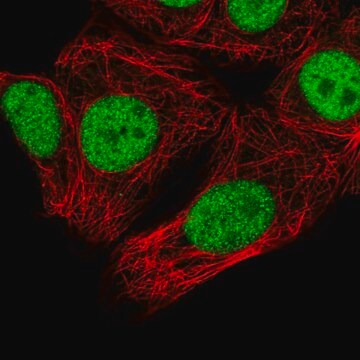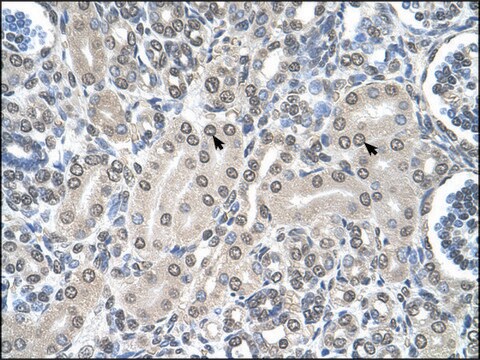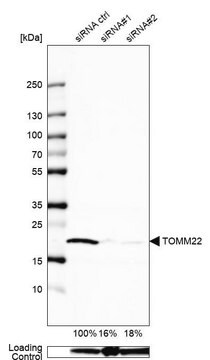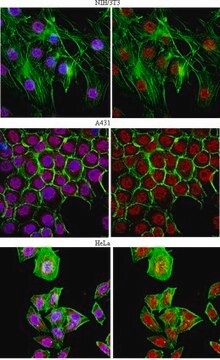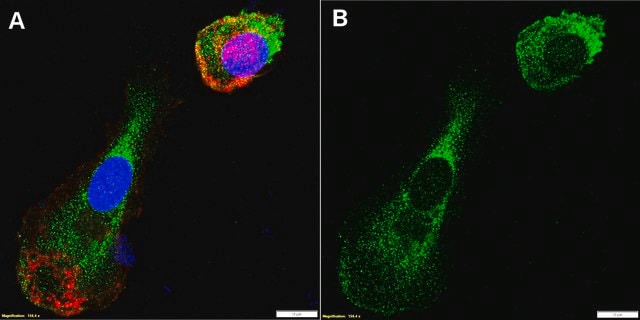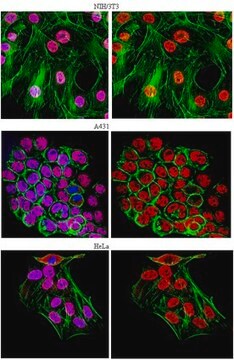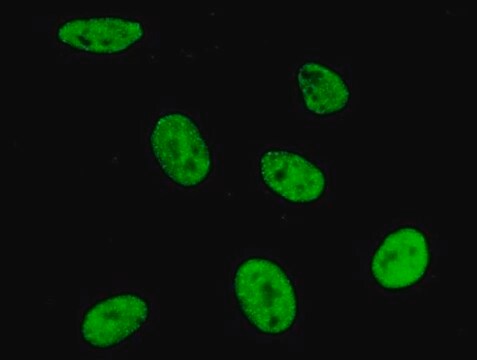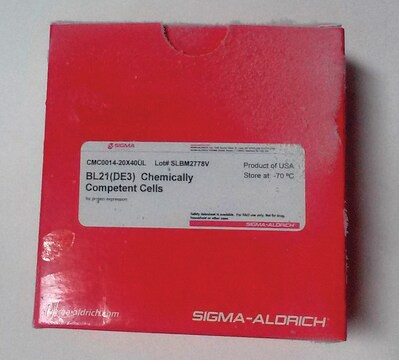推薦產品
生物源
rat
共軛
unconjugated
抗體表格
purified from hybridoma cell culture
抗體產品種類
primary antibodies
無性繁殖
4H12, monoclonal
形狀
buffered aqueous solution
分子量
~20 kDa
物種活性
human, mouse, rat, hamster, monkey
濃度
~1.0 mg/mL
技術
immunocytochemistry: suitable
immunoprecipitation (IP): suitable
western blot: 1-2 μg/mL using HeLa or COS7 or CHO cell extracts
同型
IgG2a
UniProt登錄號
運輸包裝
dry ice
儲存溫度
−20°C
目標翻譯後修改
unmodified
基因資訊
human ... SNRPC(6631)
mouse ... Snrpc(20630)
rat ... LOC685273(685273)
一般說明
Monoclonal Anti-U1 snRNP C (U1C) (rat IgG2a isotype) is derived from the hybridoma 4H12 produced by the fusion of mouse myeloma cells (SP2) and splenocytes from a rat immunized with mouse U1C protein. Small nuclear ribonucleoprotein polypeptide C (U1C) is mapped to human chromosome 6p21.31.
The U1 snRNP complex contains the U1 snRNA molecule and the U1 snRNP specific proteins U1-70K, U1A and U1C, plus a common set of eight proteins, called Sm proteins U1A and U1-70K contain RNA binding domains and interact with naked snRNA on their own.
特異性
Monoclonal Anti-U1 snRNP C (U1C) recognizes human, monkey, mouse, rat, and hamster U1C.
免疫原
mouse U1C protein fusion protein
應用
Anti-U1 snRNP C (U1C) antibody, Rat monoclonal has been used for:
- immunoblotting
- immunofluorescence
- immunoprecipitation
- immunocytochemistry
生化/生理作用
The U1 small nuclear ribonucleoprotein particle (snRNP) has an important function in the early formation of the spliceosome, the multicomponent complex in which pre-mRNA splicing takes place. The binding of U1C to the U1snRNP particle is dependent on protein-protein interactions between U1C and U1-70K as well as U1C and the common Sm proteins.
U1A and U1−70K contain RNA binding domains and interact with naked snRNA on their own. In cultured HeLa cells, mutant U1C proteins that are not able to bind to the U1 snRNP do not accumulate in the nucleus, indicating that nuclear accumulation of U1C is due to incorporation of the protein into the U1 snRNP.
外觀
Solution in 0.01M phosphate buffered saline, pH 7.4, containing 15 mM sodium azide
儲存和穩定性
Store at -20 °C. For continuous use, store at 2-8 °C for up to one month. For extended storage, freeze at -20 °C in working aliquots. Repeated freezing and thawing, or storage in “frost-free” freezers, is not recommended. If slight turbidity occurs upon prolonged storage, clarify the solution by centrifugation before use. Working dilution samples should be discarded if not used within 12 hours.
免責聲明
Unless otherwise stated in our catalog or other company documentation accompanying the product(s), our products are intended for research use only and are not to be used for any other purpose, which includes but is not limited to, unauthorized commercial uses, in vitro diagnostic uses, ex vivo or in vivo therapeutic uses or any type of consumption or application to humans or animals.
未找到適合的產品?
試用我們的產品選擇工具.
儲存類別代碼
12 - Non Combustible Liquids
水污染物質分類(WGK)
nwg
閃點(°F)
Not applicable
閃點(°C)
Not applicable
Byung Ran So et al.
Molecular cell, 76(4), 590-599 (2019-09-17)
Full-length transcription in the majority of human genes depends on U1 snRNP (U1) to co-transcriptionally suppress transcription-terminating premature 3' end cleavage and polyadenylation (PCPA) from cryptic polyadenylation signals (PASs) in introns. However, the mechanism of this U1 activity, termed telescripting, is
Crystal structure of human spliceosomal U1 snRNP at 5.5 AA resolution
Krummel DA, et al.
Nature, 458(7237), 475-475 (2009)
Binkai Chi et al.
Scientific reports, 8(1), 8755-8755 (2018-06-10)
Mutations in multiple RNA/DNA binding proteins cause Amyotrophic Lateral Sclerosis (ALS). Included among these are the three members of the FET family (FUS, EWSR1 and TAF15) and the structurally similar MATR3. Here, we characterized the interactomes of these four proteins
SMN2 splice modulators enhance U1--pre-mRNA association and rescue SMA mice
Palacino J, et al.
Nature Chemical Biology, 11(7), 511-511 (2015)
Interactome analyses revealed that the U1 snRNP machinery overlaps extensively with the RNAP II machinery and contains multiple ALS/SMA-causative proteins
Chi B, et al.
Scientific reports, 8(1), 8755-8755 (2018)
我們的科學家團隊在所有研究領域都有豐富的經驗,包括生命科學、材料科學、化學合成、色譜、分析等.
聯絡技術服務